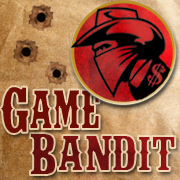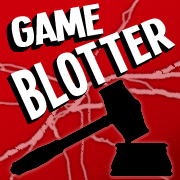 The Island of Doctor Lucky is the newest iteration of Kill Doctor Lucky by Cheapass Games. The original game, which is basically Clue before the murder, centers on the eponymous Doctor Lucky as he travels along a set path through his mansion while dinner guests attempt to kill him. The Titanic Games (a now-defunct imprint of Paizo Publishing) edition had several rooms in the sprawling mansion that weren’t on Lucky’s path, which slowed down the would-be murderers. The 19.5th Anniversary Edition removed these empty rooms (and ignored movement in hallways). With the Island of Doctor Lucky, it’s as if the mansion evolved to be just rooms that Lucky will wander through, without hallways or anything else to detract from the Doctor’s path.
The Island of Doctor Lucky is the newest iteration of Kill Doctor Lucky by Cheapass Games. The original game, which is basically Clue before the murder, centers on the eponymous Doctor Lucky as he travels along a set path through his mansion while dinner guests attempt to kill him. The Titanic Games (a now-defunct imprint of Paizo Publishing) edition had several rooms in the sprawling mansion that weren’t on Lucky’s path, which slowed down the would-be murderers. The 19.5th Anniversary Edition removed these empty rooms (and ignored movement in hallways). With the Island of Doctor Lucky, it’s as if the mansion evolved to be just rooms that Lucky will wander through, without hallways or anything else to detract from the Doctor’s path.
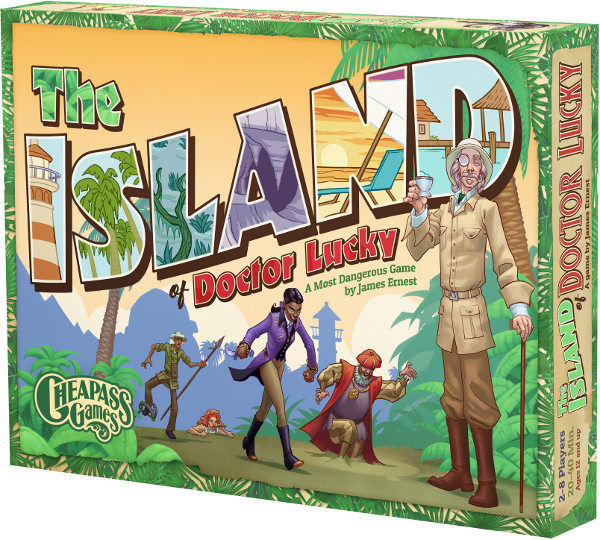
Each turn your murderer may move, then either draw a card or attempt to kill Doctor Lucky if there are no witnesses. If there is nobody in your location or an adjacent location, go for murder! In the mansion-based earlier games, checking to see if you are undiscovered required tracing sight lines through walls and open doorways up to two or three rooms away. On the island, it’s easier and faster to tell if your character is seen or unseen. Once your turn is over, Doctor Lucky moves to another space.
When attempting to kill the Doctor, the other players must discard cards with enough Luck symbols to keep him alive — we all want him dead, but we want to be the one with our hands around his scrawny neck. Eventually enough players’ cards are played that the other players won’t be able to thwart a killing. It’s always reminded me of playing Munchkin with several players at level 9, all trying to get to 10, waiting for that card attrition to assist your victory.
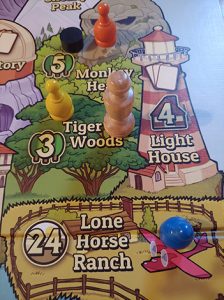 The board itself just has free-form locations depicted, which gave us a bit of pause when initially trying to find the fastest route to a target space or picturing who is visible to others. Each location has a terrain type that is referenced on new hazard cards. Hazards can be played on Lucky like any normal murder attempt or on other players, but only if the terrain type your victim is in matches the card’s. While this seems to be a good way to attempt to kill your prey (and interact with the other players), in our playthroughs it seemed like we never had the correct terrain on cards in our hands. This was a problem for us, as failing a hazard play on Doctor Lucky is how you increase your movement. Without being able to play hazards on the Doctor, we were crawling all over the island instead of rushing to an opportune position for murder.
The board itself just has free-form locations depicted, which gave us a bit of pause when initially trying to find the fastest route to a target space or picturing who is visible to others. Each location has a terrain type that is referenced on new hazard cards. Hazards can be played on Lucky like any normal murder attempt or on other players, but only if the terrain type your victim is in matches the card’s. While this seems to be a good way to attempt to kill your prey (and interact with the other players), in our playthroughs it seemed like we never had the correct terrain on cards in our hands. This was a problem for us, as failing a hazard play on Doctor Lucky is how you increase your movement. Without being able to play hazards on the Doctor, we were crawling all over the island instead of rushing to an opportune position for murder.
The Lucky Train continues in this version: if he stops in your area, it becomes your turn, even if you just went. In our three-player game (which adds three other non-player murderers to the board), we had a player with turn after turn as Lucky either ran into her token or the non-player token just before her. By our count, she wound up being able to act on the Island six times to second player’s two. That wasn’t fun for the second player and felt a bit embarrassing for the first player, getting to act three times in a row. That game ended with the third player managed to move twice, running into the doctor and playing a low-level attack card–the other two players didn’t have any cards with Luck symbols on them. Like Munchkin, it felt like the game randomly picked a victor and, like Munchkin, it seems like the time the game takes to play is determined by the draw of the cards.
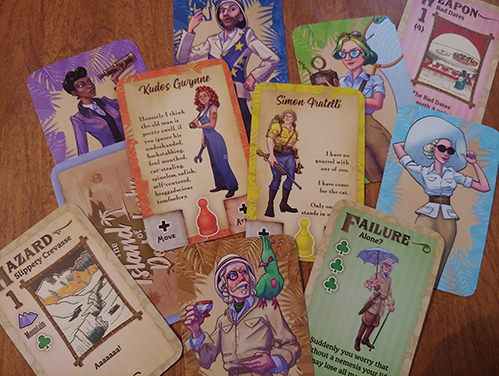
I hate to say it, but The Island of Doctor Lucky isn’t as fun as the Kill Doctor Lucky games. By moving the game from the mansion to an island, the nostalgic memories of childhood games of Clue and the theme of “Clue before Clue” are further removed. The colorful simple board where some locations are puns but others aren’t, condensing the scene of crime to a point where players can take several turns in a row, and the way hazard cards are used to increase movement (but only if used on the Doctor), coupled with the random draw of cards which might give players a game that’s much shorter than the 40 minutes on the box? Well, we’d rather go with the 19.5 Anniversary Edition, which we reviewed a few years back.
A copy of The Island of Doctor Lucky was provided free for review by Cheapass Games.
- Comments Off on Second Look—Kill Doctor Lucky… on an Island!
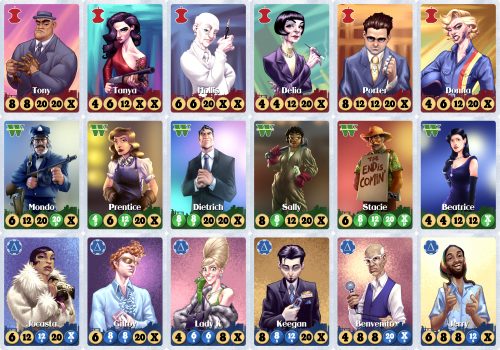
Cheapass Games has just announced the Button Men will be rising from the ashes in a new Kickstarter campaign that upgrades the classic James Ernest game from pin-back buttons to deluxe cards. Set in Fight City, a fictional 1950’s gangster town located somewhere on the Gulf Coast, the new Button Men game features four warring factions, each with their own style of play. Even though Button Men is now a card game the name still works since a “button man” is a low-level gangster.
While the game is getting a facelift, the rules are pretty much the same. This means that the new card-driven game will still be compatible with your old button collection.
The new campaign should be up sometime today and will have reward levels from $15 all the way up to $485.
- Comments Off on Button Men Returning as a Card Game from Cheapass Games
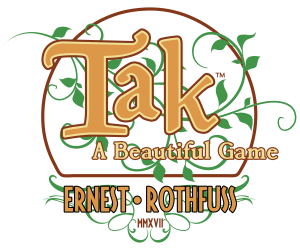 Tak, the abstract strategy game created by Cheapass Games and Patrick Rothfuss, is finally hitting store shelves after a highly successful Kickstarter campaign and reward fulfillment. Those looking to pick up the game online can also order it from The Tinker’s Packs, Rothfuss’ online store that benefits Worldbuilders.
Tak, the abstract strategy game created by Cheapass Games and Patrick Rothfuss, is finally hitting store shelves after a highly successful Kickstarter campaign and reward fulfillment. Those looking to pick up the game online can also order it from The Tinker’s Packs, Rothfuss’ online store that benefits Worldbuilders.
For those unfamiliar, Tak comes from Rothfuss’ award-winning novel The Wise Man’s Fear, the second book in The Kingkiller Chronicles. While the game is never fully explained in the book, Cheapass Games has done an amazing job creating a game the truly feels like a timeless classic.
- Comments Off on Cheapass Games’ Tak Hits Retail
Second Look—Kill Doctor Lucky 19.5 Anniversary Edition
24 Sep
Posted by Rob Kalajian as Classic Board Games, Modern Board Games
 People have been trying to kill Doctor Lucky for 20 years now, so what better way to celebrate than with Cheapass Games’ Kill Doctor Lucky 19.5 Anniversary Edition. The game has been out of print since 2006, so I’m sure people are going to be happy it’s back on the market. It’s packed full of all the Lucky killing action that players have come to know and love and adds just a bit more polish to the game.
People have been trying to kill Doctor Lucky for 20 years now, so what better way to celebrate than with Cheapass Games’ Kill Doctor Lucky 19.5 Anniversary Edition. The game has been out of print since 2006, so I’m sure people are going to be happy it’s back on the market. It’s packed full of all the Lucky killing action that players have come to know and love and adds just a bit more polish to the game.
Now I have to admit that I’ve never actually played Kill Doctor Lucky before this, so I can’t compare editions. What I can do is tell you how much I enjoyed the game with two of my boys. Killing Doctor Lucky, as it turns out, is a pretty fun thing to do. All the flavor text on the character cards, weapons cards, and pretty much anywhere else they can fit flavor text, it hilarious to read. That, and ruining someone’s chance to kill the good doctor both bring a very satisfying element to the game.
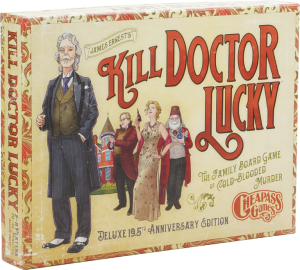 I should mention there’s a bunch of variations of the game included in the box, but so far we’ve just played the standard version where you’re trying to kill the old man. In one variation there’s a cat that is placed on the board and moved instead of your player pawn. If the cat is in a room with any player, they can’t see out of that room. There’s also rules for a variation of the game where Doctor Lucky comes back as a ghost and tries to kill all the players.
I should mention there’s a bunch of variations of the game included in the box, but so far we’ve just played the standard version where you’re trying to kill the old man. In one variation there’s a cat that is placed on the board and moved instead of your player pawn. If the cat is in a room with any player, they can’t see out of that room. There’s also rules for a variation of the game where Doctor Lucky comes back as a ghost and tries to kill all the players.
I really can’t believe I’ve never played this game before today. It’s a fun and humorous game with simple rules, a bit of bluffing, and a lot of attempted murder. The 19.5 Anniversary Edition is available now for $40, which is about $10 too high in my opinion. Nevertheless, this feels like one of those games that should be in every gamer’s collection.
A copy of Kill Doctor Lucky 19.5 Anniversary Edition was provided free for review by Cheapass Games.
- Comments Off on Second Look—Kill Doctor Lucky 19.5 Anniversary Edition
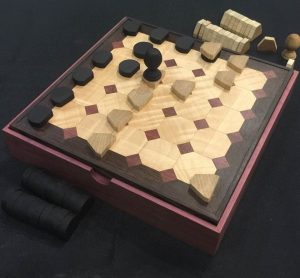 The US Tak Association is hosting the 2016 Tak Open Online Tournament beginning this week via PlayTak.com. The tournament will be run Swiss-style tournament, and games will be played on a 5×5 Tak board. Play will switch to a 6×6 board during the final rounds.
The US Tak Association is hosting the 2016 Tak Open Online Tournament beginning this week via PlayTak.com. The tournament will be run Swiss-style tournament, and games will be played on a 5×5 Tak board. Play will switch to a 6×6 board during the final rounds.
First and second place winners will receive gorgeous purpleheart, wenge, and kingwood Tak sets handcrafted by tournament sponsor Wyrmwood Gaming.
Registration will end this Tuesday, 9/13.
- Comments Off on 2016 Tak Open Online Tournament
 Another card game demoed at the show and reminiscent of Liar’s Dice is Deadfall ($10, now) from Cheapass Games. This one can be played with a standard deck of the company’s Pairs cards but is also being sold in its own packaging with a special fantasy themed deck. A Pairs deck, for those unfamiliar, contains cards numbered 1-10, with one 1, two 2s, three 3s, and so on.
Another card game demoed at the show and reminiscent of Liar’s Dice is Deadfall ($10, now) from Cheapass Games. This one can be played with a standard deck of the company’s Pairs cards but is also being sold in its own packaging with a special fantasy themed deck. A Pairs deck, for those unfamiliar, contains cards numbered 1-10, with one 1, two 2s, three 3s, and so on.
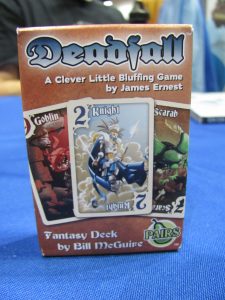 Deadfall is played as a gambling game. Players ante a coin in to the pot and throw down one card to determine who goes first. Starting with the one who played the highest card, each in turn plays a single card that’s supposed to indicate a number which they believe still remains in someone’s hand. That is, unless it’s a bluff.
Deadfall is played as a gambling game. Players ante a coin in to the pot and throw down one card to determine who goes first. Starting with the one who played the highest card, each in turn plays a single card that’s supposed to indicate a number which they believe still remains in someone’s hand. That is, unless it’s a bluff.
Alternatively, a player can challenge any other player’s last card in the round, at which point everyone reveals their remaining hands.
Between the challenger and the challenged, the person who’s correct wins the pot, as well as a penalty from the other equal to the challenged card number.
- Comments Off on Gen Con 2016—Deadfall
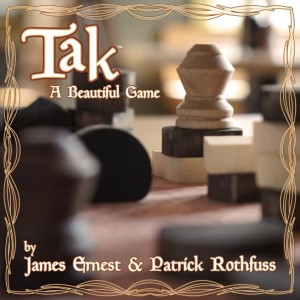
The US Tak Association (USTA), announced its formation formation today. Their goals are to “share and promote the game of Tak,” and promoting “fair and competitive play by establishing a comprehensive set of rules and standards that can be used for tournaments and other events.”
Cassidy Werner, marketing director at Cheapass Games: “The USTA has our full support.”
Along with this news, Wyrmwood Gaming has announced a Year 0 Tak tournament at Gen Con. Every participant will win a prize, while First, Second, and Third place players will receive custom prizes crafted by Wyrmwood Gaming. Space is limited; those interested in participating should sign up for the tournament as soon as possible.
- Comments Off on US Tak Association Announced

I hesitated for a while to write up Tak. Given the few games I’ve played, I’ve clearly just scratched the surface. But then again, that’s what I already enjoy about the game. With such simple rules, there’s so much to explore. Tak is one of those abstract games that manages a lot of challenging play in a very uncomplicated package.
I’ve also never read the novel from which the game is derived, The Wise Man’s Fear by Patrick Rothfuss. And yet, perhaps even more than the interesting game play, it’s the imagined history and culture of Tak that has me so engaged.
The game works like this… On your turn you either place a piece (called a “stone”) on an empty square—standing up or laying flat—or you move a single stack of stones already on the board in a straight line, dropping some from the bottom of the stack in every space along the way. Generally, you can’t place a stone on top of a standing stone, that is, unless you do so with the special capstone piece to flatten it. Winning is accomplished by connecting any two board edges with a contiguous line of flat stones, and that is called a “road”.
Tak players of antiquity played with hand-carved pieces of various shapes and sizes. Some were just wooden squares or rounded stones; some were intricately decorated. Standard colors, shapes, and sizes for the pieces vary from time to time and place to place. Travelers typically played 5×5, using simple wooden pieces and an improvised board (or no board at all). Court players typically played the larger 6×6 game. Capstones could be highly specialized, and Tak players often carry their own personalized capstone, even if they don’t carry a whole set.
…So the instructions go, interspersing rules with brief lessons on the game’s archaeology, etiquette, unique terminology, and varying styles of play—short but one of the most enjoyable board game rule books I’ve ever read.
Cheapass Games’ Kickstarter project for Tak has just 10 days to go but is already funded 10 times over. Backers have options for different stone sets, beautiful wood boards, and a book with more on the game’s fictional history.
- Comments Off on Kickstarter Preview—Tak
 So we had just finished playing the fully-colored Paizo edition of Kill Doctor Lucky when I received an inquiry from Cheapass Games: would I be interested in reviewing a new edition of the game? Well, with that timing, how could I not?
So we had just finished playing the fully-colored Paizo edition of Kill Doctor Lucky when I received an inquiry from Cheapass Games: would I be interested in reviewing a new edition of the game? Well, with that timing, how could I not?
But instead of just reviewing what was in the box they sent me – and let’s be upfront about this, it was a playtest version with “the finest placeholder art available” – I thought it might be helpful to compare the two editions. So the “really pretty” version you see below in my hastily-taken-in-poor-lighting photos is the older Paizo (aka Titanic Games) version; the “slightly less so” version is the currently-at-Kickstarter 19.5th Anniversary Edition.
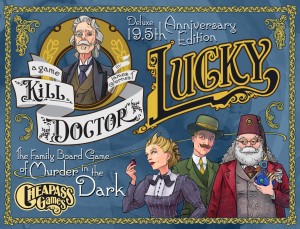 The game in a nutshell: It’s Clue (Cluedo) before the murder. You all want Doctor Lucky dead, but everyone wants to do the man in. Follow the codger around as he wanders the halls and try to kill him without being spotted.
The game in a nutshell: It’s Clue (Cluedo) before the murder. You all want Doctor Lucky dead, but everyone wants to do the man in. Follow the codger around as he wanders the halls and try to kill him without being spotted.
Let’s start with the board itself: there have been a few structural changes to stately Lucky Manor since we last tried to knock off the old coot. There are stairs leading up from the Dining Hall to the left and right, opening up sight lines from the Lancaster Room through the Dining Hall to the Lilac Room. Every room is now numbered, which means that the doctor will be stopping in every room, instead of skipping past places the White Room and Wine Cellar. Although he’s taking a slower route through the mansion, the mansion scales with players: playing a three player game? Close both east and west wings (the rooms along the left and right sides). 4 to 5 players? Close one wing.
Foiling the murder attempt with luck for the doctor doesn’t just happen with Failure cards; any possible card can have luck icons on them. Each time you fail in a murder attempt, instead of grabbing a Spite token, you keep one of the luck cards played on you as a “Reason”, but they’re pretty much the same thing.
There’s a few other tweaks: You only draw cards when you aren’t seen by anyone. You don’t count hallways as steps (which means you can go from the Dining Hall almost anywhere in the house – even all the way to the Hedge Maze). Weapons add to your basic murder value of 1. Doctor Lucky is now a cat person instead of a dog person.

So, how does it play?
It is a bit different. Faster for certain. The Paizo version’s game is really one where you bleed the Failure cards out of your opponent’s hands to make that one sudden murder attempt that nobody can counter. That version feels a bit like Munchkin in that way, with the “can anyone stop this guy?” moment and the sheepish looks around the table that heralds the end of the game. But in the new version, the luck symbols are on (nearly) every card. There really isn’t the long first half of the game where you’re actively attempting small murder attempts in order to weed out the Failure cards. Well…there is a slight bit of that, but that phase is significantly shorter due to luck being scattered throughout the deck.
That scattering of luck also adds some strategic planning: you can stop a murder attempt by spending a two-luck card, but when that’s a Move-2 card that could also get you across the mansion, do you really want to? Even with that, the new version is quicker than the earlier version and hits the fun spot a lot more sooner.
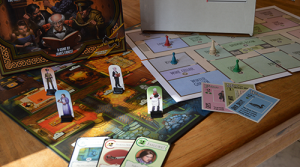 The game is more about skulking around the mansion than drawing cards. You’ve got to be hidden from everyone – including Doctor Lucky – to draw cards, but you also want to position yourself to deny the next player an opportunity to kill off the old man. But do that, you don’t get to draw cards yourself. I kind of like that, but I’m disliking how the new mansion feels smaller: more open sight lines, closing rooms down, and having the hallways open – wide open – to let people move around the mansion easier, and folding room cards into the move ones makes it decidedly harder to hide and get those card draws. When playing with three players (which is the size of my family group), there’s half the board you aren’t using. This is tempting me to try out the 19.5th Anniversary Edition rules on the Paizo board, just to see what happens.
The game is more about skulking around the mansion than drawing cards. You’ve got to be hidden from everyone – including Doctor Lucky – to draw cards, but you also want to position yourself to deny the next player an opportunity to kill off the old man. But do that, you don’t get to draw cards yourself. I kind of like that, but I’m disliking how the new mansion feels smaller: more open sight lines, closing rooms down, and having the hallways open – wide open – to let people move around the mansion easier, and folding room cards into the move ones makes it decidedly harder to hide and get those card draws. When playing with three players (which is the size of my family group), there’s half the board you aren’t using. This is tempting me to try out the 19.5th Anniversary Edition rules on the Paizo board, just to see what happens.
Should you back the Kickstarter? Well, if you like Kill Doctor Lucky and have at least four players: yeah, it’s a no-brainer. The game is faster, funner, than before. Three or fewer players? I doubt this will hit the table as often because there’s that half of the board you can’t use just sitting there, game after game. Mocking you and your tiny widdle gaming group. There’s a two-player variant that is included in the playtest rules that introduces two dummy players and opens up one wing, but that’s a very playtest variant and might make it into the final rules.
- Comments Off on Kill Doctor Lucky…Again!
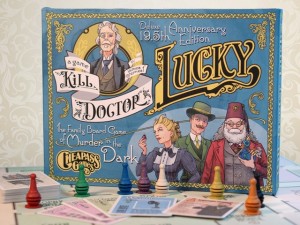 Though Cheapass Games’ classic has seen a number of reprints over the years, the new Deluxe Anniversary Edition of Kill Doctor Lucky will have revised rules and a refined map-board. Think of the game as a wacky prequel to Clue. Players move their pieces around a map of the mansion, attempting to catch up with Dr. Lucky and kill him without any witnesses. Should someone manage to find him alone, opposing players, however, still have an opportunity to play their cards in Dr. Lucky’s favor, giving him that quick boost of luck that allows him to escape murder—temporarily.
Though Cheapass Games’ classic has seen a number of reprints over the years, the new Deluxe Anniversary Edition of Kill Doctor Lucky will have revised rules and a refined map-board. Think of the game as a wacky prequel to Clue. Players move their pieces around a map of the mansion, attempting to catch up with Dr. Lucky and kill him without any witnesses. Should someone manage to find him alone, opposing players, however, still have an opportunity to play their cards in Dr. Lucky’s favor, giving him that quick boost of luck that allows him to escape murder—temporarily.
Kobold Press is putting together a book of 300 new monsters for 5th edition Dungeons & Dragons, as well as a collection of monster lairs with detailed battle maps. Backers can get the Tome of Beasts, the Book of Lairs, or both, in any combination of print or PDF.
Scythe is a Euro-style 4X game set in an alternate-history version of early 20th century Eastern Europe. It has mech miniatures, deterministic combat, and unique factions. And as Stonemaier Games is wont to do, the game is available in premium, collector, and connoisseur editions with metal coins, plastic modeled resource bits, and an art book.
Ninja Star Games’ Wolf & Hound is a card game played in partnerships. As shepherds, the goal of players is to manipulate the wolf in to chasing away their opponents’ sheep, while using the sheepdog to rescue their own sheep from the forest.
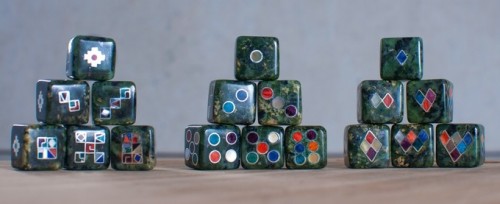
Machu Picchu Dice are to be hand-made in Cusco, Peru from Nephrite stone inlaid with silver, chrysocolla, lapis lazuli, spondylus, and abalone. Available in three styles, a pair of dice will run $39-55.
High-tech instead of artisanal, Boogie Dice are self-rolling. They respond to sudden noises, such as clapping or the snapping of fingers, by bouncing around of their own accord. What this accomplishes, I have no idea but it sure is cool. A pair with charging station goes for $38. If the project gets to $200k, they’ll also make 20-sided boogie dice.
Trending
- Massdrop.com
- Oh the Irony—Illuminati Card Game Continues to Inspire Conspiracy Theorists
- Footprints, an Educational Ecology Game
- USPS Adds Board Game Flat Rate Box
- Home
- Baila, the Estonian Drinking Card Game
- Crystal Caste Wins Dice Patent Suit Against Hasbro
- Mirror Game, Red and Blue
- Hasbro and Mattel Merger?
- Are Board Games Dangerous?
Archives
Most Popular Articles
- Oh the Irony—Illuminati Card Game Continues to Inspire Conspiracy Theorists
- The 20 Most Valuable Vintage Board Games
- The Truth About Dominoes On Sunday in Alabama
- Sequence Game, and Variants
- USPS Adds Board Game Flat Rate Box
- Baila, the Estonian Drinking Card Game
- The 13 Most Popular Dice Games
- Are Board Games Dangerous?
- Guess Who? The Naked Version
- What Happened to the Jewel Royale Chess Set?
Recent Posts
- Toy Fair 2019—Breaking Games
- Talisman Kingdom Hearts Edition
- Toy Fair 2019—Winning Moves
- Toy Fair 2019—Games Workshop
- Toy Fair 2019—Star Wars Lightsaber Academy
- Toy Fair 2019—Stranger Things Games
- Toy Fair 2019—HABA
- Licensing Roundup
- Game Bandit
- 2018 A Difficult Year For Hasbro But Not For D&D Or MtG
Recent Comments
- on Toy Fair 2019—Winning Moves
- on Game Bandit
- on Second Look—Dungeons & Dragons Waterdeep Dragon Heist
- on Crowdfunding Highlights
- on Beyblade SlingShock
- on Game Bandit
- on Game Bandit
- on Watch This Game!, the Board Game Review Board Game
- on Second Look—Vampire: The Masquerade 5th Edition
- on Palladium Books Loses Robotech IP License, Cancels Five-Year-Overdue Robotech RPG Tactics Kickstarter


